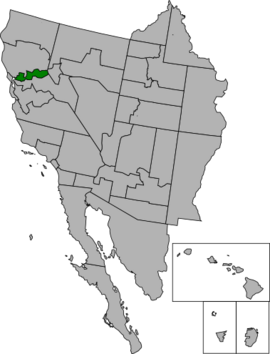Tahoe: Difference between revisions
Centrist16 (talk | contribs) |
(Tahoe template included.) |
||
| Line 159: | Line 159: | ||
==See also== | ==See also== | ||
{{Tahoe topics}} | |||
{{Sierra PD}} | {{Sierra PD}} | ||
{{Sierra KS}} | {{Sierra KS}} | ||
Revision as of 10:16, 31 December 2020
| Province of Tahoe (en) Tahoe (es) Tahoe (fr) Тахо (ru) Tahoe (tn) 太浩 (zh) Ta-hô (vn) 타호 (kr) タホ州 (ja) Tahoe (de) | |||||
|---|---|---|---|---|---|
| — Province of Sierra — | |||||
| |||||
| Nickname(s): The Indomitable Province (official), The First Province, The 49er Province, The Christmas Province, The Lake Province, The Rebel Province | |||||
| Motto(s): "Serve the people first" | |||||
| Provincial song(s): "Beautiful Tahoe", "I'll Be Home in Tahoe" | |||||
| Official language(s) | |||||
| Demonym | Tahoean(s) | ||||
| Capital (and largest city) | Sacramento | ||||
| Area | Ranked 19th | ||||
| • Total |
5,035 sq mi (13,040 km2) | ||||
| Population | Ranked 12th | ||||
| • Total | 2,634,167 (2020) | ||||
| • Density |
523.17/sq mi (202.00/km2) Ranked 4th | ||||
| Elevation | |||||
| • Highest point |
Sonora Peak 11,464 ft (3,494 m) | ||||
| • Lowest point |
Sacramento Valley 89 ft (27 m) | ||||
| Admission to the Union | November 27, 1858 (1st) | ||||
| Lord Superintendent | Dusty Jones | ||||
| Governor | Aleena Dukakis | ||||
| Lieutenant Governor | Doug Dixon | ||||
| Legislature | Tahoe Provincial Legislature | ||||
| • Upper house | Senate | ||||
| • Lower house | House of Representatives | ||||
| K.S. Senators |
Gary Newsom (DR) Wilbur Schlatt (DR) Peter Shulga (DR) | ||||
| K.S. House delegation |
10 total commoners 5 Democratic-Republicans 4 Social Democrats 1 Royalist | ||||
| Time zone |
Pacific Time Zone UTC –8/UTC –7 | ||||
| Abbreviations | TA, TA, KS-TA, TAH | ||||
|
| |||||
Tahoe is a province located in the Styxie region of Sierra. The province is the 19th largest by area, and the 12th most populous PSA. It is bordered to the north with Plumas and Washumko, to the east with Reno, to the south with San Joaquin, and to the west with San Francisco indirectly through San Francisco Bay. It was admitted on November 27, 1858 as the 1st province in order of admission. Its capital and largest city is Sacramento. It takes it name from Lake Tahoe (which straddles Tahoe's provincial line with Reno), itself named after the Washo word for "the lake" (dá'aw).
Tahoe was historically populated by various Amerindian tribes including the Nisenan, the Modoc, and the Plains Miwok for thousands of years. The first Europeans to explore the Sacramento Valley and Sacramento River in present-day Tahoe were the Spanish under the exploratory campaign of Gabriel Moraga. The Dutch from the colony of New Holland later explored the area but the area remained largely ignored by European settlers until the late 1830s when the Mexican government awarded land grants to Californios and Anglo-Americans. John Sutter, a German-born Mexican citizen of Swiss descent, was granted 50,000 acres of land at the divergence between the American and Sacramento Rivers where he founded Sutter's Fort and his Swiss-inspired New Helvetia settlement. New Helvetia and the rest of Tahoe garnered significant interest after the end of the Mexican–American War and independence of California when gold was discovered in 1848 on Sutter's land. Tahoe grew rapidly during and following the California Gold Rush and was the most populous state in the California Republic. On November 27, 1858, Tahoe was admitted as the first province of the Kingdom of Sierra.
Etymology
Tahoe is named after Lake Tahoe, a large freshwater lake which the province shares with Reno and Plumas on its eastern borders. The lake is the largest body of freshwater in Sierra, the largest alpine lake in North America, the largest non-Great Lakes body of water in the continent by volume, and the second deepest lake in North America after Crater Lake in Astoria. The English name is based off of the Washo word, Dá'aw, which translates into "The Lake". The name was adopted when the State of Tahoe was organized under the California Republic, and was retained when the state was converted into a province under the Kingdom of Sierra.






